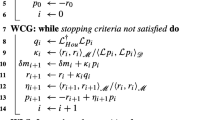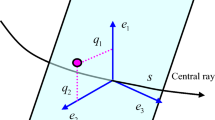Abstract
The one-way propagation operator in the frequency-space domain has the advantages of fast calculation speed and good adaptability to medium with lateral velocity variation. The full wavefield model constructed by the one-way propagation operator is iterative. As the number of iterations increases, the components of wavefield are more and more abundant. In the full wavefield model, the propagation and scattering processes are independent of each other. The former is determined by the propagation operator, while the latter is determined by the scattering operator. As each iteration increases, the wavefield component will increase by one order. As an inverse migration operator, the full wavefield model could feed back the imaging result to the data. By calculating the residual between the simulated data and the actual data, the reflectivity is updated. This is an inversion process. In this process, multiples will be imaged. In this way, the subsurface information contained in multiples is utilized and the imaging quality is greatly improved. The L1-norm is used to constrain the imaging result, which further suppresses the artifacts and improves the imaging resolution. We have made some numerical examples in 2D case, explaining the principles and advantages of this methodology.






Similar content being viewed by others
References
Berkhout AJ (1982) Seismic migration: imaging of acoustic energy by wave field extrapolation a: theoretical aspects, 2nd edn. Elsevier, Amsterdam. ISBN 0-444-41904-7
Berkhout AJ (2011) Combining full wavefield migration and full waveform inversion. In: 81st SEG meeting, San Antonio, USA, expanded abstracts, pp 3321–3325
Berkhout AJ (2012) Combining full wavefield migration and full waveform inversion: a glance into the future of seismic imaging. Geophysics 77(2):S43–S50
Berkhout AJ (2014a) Review paper: an outlook on the future of seismic imaging, part II: full-wavefield migration. Geophys Prospect 62(5):931–949
Berkhout AJ (2014b) Review paper: an outlook on the future of seismic imaging, part I: forward and reverse modelling. Geophys Prospect 62(5):911–930
Broggini F, Snieder R, Wapenaar K (2013) Data-driven Green’s function retrieval and imaging with multidimensional deconvolution: numerical examples for reflection data with internal multiples. In: 83rd SEG meeting, Houston, USA, pp 4156–4161
Davydenko M, Verschuur DJ (2016) Full-wavefield migration: using surface and internal multiples in imaging. Geophys Prospect 65(1):7–21
Fleury C, Snieder R (2012) Increasing illumination and sensitivity of reverse-time migration with internal multiples. In: 74th EAGE annual conference and exhibition, Copenhagen, Denmark, expanded abstracts, pp 4–7
Li Q, Wang D, Zhou J (2018) One-way propagation operator to simulate the two-way wavefield and application on surface-related multiples image. In: 80th EAGE conference and exhibition
Malcolm AE, Ursin BR, de Hoop MV (2009) Seismic imaging and illumination with internal multiples. Geophys J Int 176(3):847–864
Ning T, Herrmann FJ (2015) Fast least-squares imaging with surface-related multiples: application to a North Sea data set. Lead Edge 34(7):788–794
Soni AK, Verschuur DJ (2014) Full-wavefield migration of vertical seismic profiling data: using all multiples to extend the illumination area. Geophys Prospect 62(4):740–759
Thorbecke JW, Wapenaar K, Swinnen G (2004) Design of one-way wavefield extrapolation operators, using smooth functions in WLSQ optimization. Geophysics 69(4):1037–1045
Van Groenestijn GJ, Verschuur DJ (2009) Estimating primaries by sparse inversion and application to near-offset data reconstruction. Geophysics 74(3):A23–A28
Verschuur DJ (1990) Surface-related multiple elimination in the presence of near-surface anomalies. SEG Technical Program Expanded Abstracts, vol 9, no 1, p 1622
Verschuur DJ, Berkhout AJ (2011a) Seismic migration of blended shot records with surface-related multiple scattering. Geophysics 76(1):A7–A13
Verschuur DJ, Berkhout AJ (2011b) Seismic migration of blended shot records with surface-related multiple scattering. Geophysics 76(1):A7–A13
Verschuur DJ, Berkhout AJ, Wapenaar CPA (1991) Surface-related multiple elimination: application on real data. SEG Technical Program Expanded Abstracts, pp 1476–1479
Verschuur DJ, Berkhout AJ, Wapenaar CPA (1992) Adaptive surface-related multiple elimination. Geophysics 57(9):1166–1177
Wang G, Alkhalifah T, Guo Q, Wang S (2019) Frequency domain generalized internal multiple imaging with energy norm. In: 81st EAGE meeting
Wapenaar K, Broggini F, Slob E, Snieder R (2013) Three dimensional single-sided Marchenko inverse scattering, data-driven focusing, Green’s function retrieval, and their mutual relations. Phys Rev Lett 110:084301
Yuan SY, Wang SX, Yuan FF, Liu Y (2018) The influence of errors in the source wavelet on inversion-based surface-related multiple attenuation. Geophys Prospect 66:55–73
Acknowledgements
The author would like to thank the supervisor Professor Deli Wang for his guidance and help as well as many useful discussions and suggestions from Professor Eric Verschuur. The author would also like to thank the National Natural Science Foundation (No. 41374108) and the National Major Science and Technology Project of China (2016ZX05026-002-003) for their sponsorship.
Author information
Authors and Affiliations
Corresponding author
Rights and permissions
About this article
Cite this article
Li, Q., Wang, D. Multiples inversion imaging using a one-way propagation operator. Acta Geophys. 67, 1341–1348 (2019). https://doi.org/10.1007/s11600-019-00318-x
Received:
Accepted:
Published:
Issue Date:
DOI: https://doi.org/10.1007/s11600-019-00318-x




